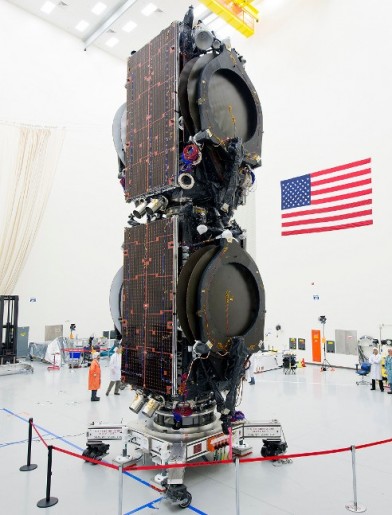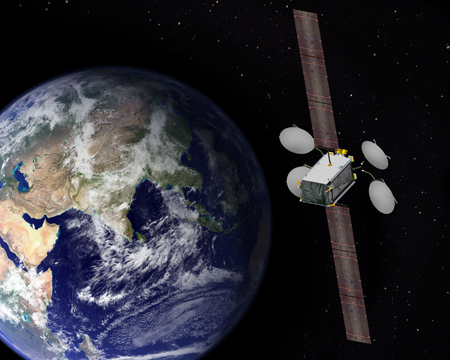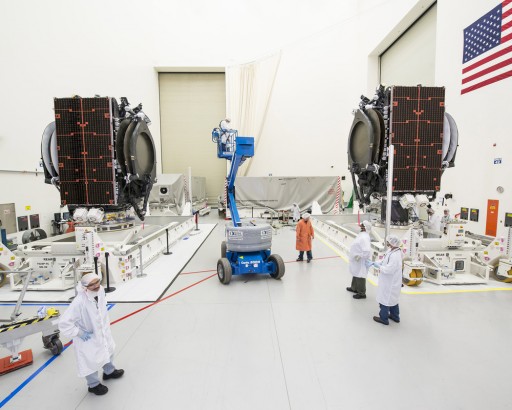Eutelsat 115 West B

Eutelsat 115 West B is a commercial geostationary communications satellite operated by Eutelsat Americas, formerly Satmex, and built by Boeing Satellite Systems. The spacecraft is part of an order of four satellites from ABS and Satmex based on the same Boeing bus. the four satellites are launched in pairs as part of dual-payload missions.
The spacecraft is based on the BSS-702SP platform, the smallest in the 702 satellite bus series provided by Boeing. 702SP was inaugurated in 2012 and passed its Critical Design Review in May 2013 after which production was started. The satellite minimizes the larger 702HP and MP satellite buses and relies on an all-electric propulsion system which frees up volume for the satellite payload and reduces the mass of the satellite by eliminating a chemical propulsion system. The 702SP satellites support a payload power range from 3 to 8 Kilowatts.
The 702SP satellite bus is about 4.6 meters tall and 2.1 meters wide with a typical launch mass of 1,800 to 2,500 Kilograms. The satellite consists of a central cylindrical structure that acts as the primary load-carrying element of the spacecraft. Aluminum honeycomb side panels are used to provide mounting structures for the various satellite systems. A modular approach is used to allow the standard bus modules to be integrated with the custom-made payload modules late in the assembly process and a separation between bus and payload thermal control systems increases the overall efficiently of the design. The 702SP bus can facilitate communication payloads with up to five antenna reflectors.
Boeing has developed a patented system to launch two 702SP based satellites in a stacked fashion without any adapter needed between the satellites. According to Boeing, the satellite riding in the lower position does not require any structural modifications to support the loads of the upper satellite, only using its central load-bearing structure to support the uppermost satellite. The two satellites are separated after orbital insertion, allowing them to be treated as a single payload which reduces complexity for the launch services provider.
Electrical power is generated by two deployable solar arrays and stored in Li-Ion batteries with dedicated avionics conditioning the satellite power bus that supplies electrical power to the various bus systems, the electric propulsion system and the satellite payload. The satellites use a state of the art attitude determination and control system utilizing star trackers and Earth sensors for precise attitude determination and reaction wheels for accurate pointing.

The 702SP satellite platform uses a pure electrical propulsion system that performs the insertion of the satellite from its transfer orbit into Geostationary Orbit, stationkeeping in the GEO slot and desaturations of the reaction wheels at regular intervals to manage wheel momentum.
XIPS, the Xenon Ion Propulsion System, has flown on numerous spacecraft and is ten times more efficient than the conventional chemical propulsion systems, the only disadvantage being the low thrust that can be achieved with the system leading to a longer time frame needed between launch and Beginning of Service. Ion thrusters generate thrust by accelerating ions through the use of an electric field and ejecting these ions at extremely high velocity creating thrust force propelling the spacecraft forward. Although ion thrusters deliver a very low thrust, they are extremely efficient and consume only a very small amount of propellant. The method of ion acceleration varies between the use of Coulomb and Lorentz force, but all designs take advantage of the charge/mass ratio of the ions to create very high velocities with very small potential differences which leads to a reduction of reaction mass that is required but also increases the amount of specific power compared to chemical propulsion.

The XIPS-25 system used by the 702SP spacecraft consists of a central Xenon tank and four 25-centimeter ion thrusters. Required power varies between 1,300 and 4,500 Watts achieving a thrust of up to 165 Millinewtons and a specific impulse of 3,500 seconds. Two of the four thrusters are used as primary units at any given time and stationkeeping in Geostationary Orbit will require four burns for a total of about 30 minutes per day to maintain the satellite within a 0.01 degree stationkeeping zone which allows many satellites to be collocated in a single orbital slot.
The Eutelsat 115 West B satellite is outfitted with 12 C- and 34 Ku-Band transponders to deliver Fixed Satellite Services in the Americas. Stationed at 114.9° West in Geostationary Orbit, the satellite provides coverage across America. A C-Band Pan-American beam provides coverage from Alaska over the western portion of Canada and the United States to Mexico, Latin America and the north-western regions in South America. The Ku-Coverage is split in several beams, one covering Mexico and surrounding territories, another covers the majority of South America with the exception of the north eastern regions, and a third covers the entire United States (except Florida) and Canada.
Services delivered by the satellite include Direct to Home television, broadband applications, mobility services, VSAT solutions and special coverage for government and private customers.
The satellite is expected to operate for at least 15 years.
